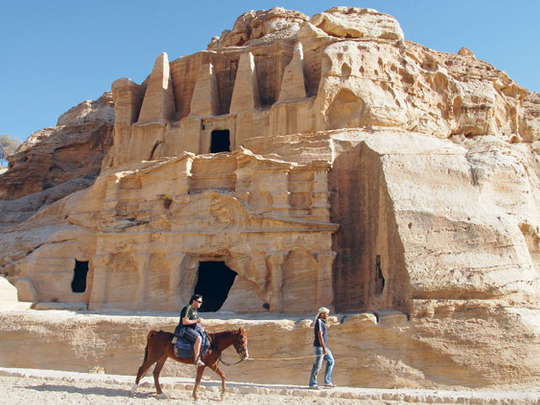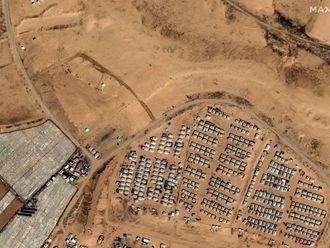
Petra, Jordan: Conservation experts almost gave up when they first saw the severely damaged wall paintings they had come to rescue in the ancient city of Petra.
Cloaked for centuries in grimy soot from bedouin campfires, the blackened murals appeared beyond repair.
But three years of restoration revealed intricate and brightly-coloured artwork, and some of the very few surviving examples of 2,000-year-old Hellenistic wall painting.
"It has actually been quite nerve-racking. We didn't actually realise that we could clean this painting and when we started we thought that would be impossible. It only emerged halfway through," said conservation expert Stephen Rickerby, waving his hand at the decorated mural.
The spectacular paintings are located in the canyon of Siq Al Barid in Beidha, known as "Little Petra" about five kilometres from Petra itself.
Petra enjoys fame for the carved rock ruins left by the Nabateans, an Arab civilisation that arose centuries before Jesus and survived until Roman legions incorporated it into their vast empire.
The Nabateans flourished in the second century BC and dominated the long distance caravan trade that brought incense and aromatics from South Arabia to the Mediterranean.
Absorbing artistic influences from across their empire, they adopted Hellenistic styles in many of their cities and their newly restored paintings at Petra are some of the very few — and most detailed — remaining examples.
"Most paintings that survived were very simple. This is figurative. It's real art as opposed to decorative," said Rickerby, who restored the paintings alongside his colleague Lisa Shekede from London's Courtauld Institute of Art.
The most visible scenes that cover the vault and the walls of the cave complex are populated by winged putti — or child-like figures — who pick fruits or fight off birds pecking at the grapes, the conservationists said.
Painted ruins
Petra's monumental ruins were originally painted, but centuries of exposure to the elements wore them down to reveal the "rose-red" stone for which the site is best known.
"Everybody knows Petra for its rock monuments. Very few people do realise that these monuments were painted," Rickerby said. "We have to imagine Petra as a painted city. This sight now gives us a glimpse of what the whole of Petra was like."
For the Amarin Bedouin of Beidah, the paintings offer hope that tourists will venture beyond Petra's ancient city centre to explore some of its outlying secrets, many of which remain buried under collapsed buildings and drifting sands.
"I think it is going to be a new tourist attraction and it is already attracting more and more people," Rickerby agreed.
The cave where the paintings were found is among hundreds of elaborate tombs and temples, carved into the sandstone cliffs around the arid valleys of Petra.
"What we have accomplished has revealed a painting of stunning beauty and historic value and it tells us a lot about the culture of the Nabateans, their exceptional taste and their use of expensive pigments like gold," Rickerby said.
"We are seeing a high point of Nabatean art at this time."
The naturalistic intricacy of the Jordanian paintings is shown by flowers, birds and insects that can all be spotted.
The scenes identify three different vines: grape, ivy and bindweed, all associated with Dionysus, the ancient Greek deity of wine.
"Hellenism is quite strong here ... in the figurative style of the painting and in the naturalism of the representations of the birds and the wines," Skekede said.












